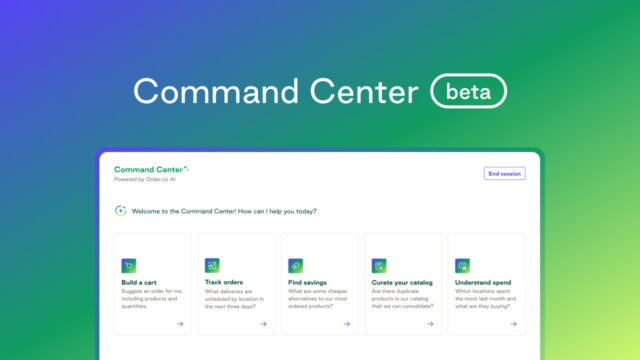Use These Tips for a More Effective Retail Sourcing Strategy

Use These Tips for a More Effective Retail Sourcing Strategy
Selection is what sets great retailers apart. Whether a brick-and-mortar location or an online shopping site, customers flock to stores that offer variety and choice. That makes strong sourcing one of the retail industry's biggest competitive advantages.
While finding fun and functional products can be complex, it gets a lot easier with the right mix of strategy and tools—especially when you're buying for locations with different needs.
Let’s look at how centralized vendor management, cloud-based procurement software, and real-time analytics can help you improve product selection, reduce sourcing risk, and make purchasing more sustainable.
The importance of having a smart retail sourcing strategy
Sourcing is the backbone of retail operations. It helps you save money, maintain control over product quality, and get the goods you want on time and on budget.
But if your sourcing strategy lags, it can lead to some costly and frustrating roadblocks. Without a solid process, you're more likely to hit these purchasing speed bumps:
- Higher costs due to last-minute orders, lax price negotiations, or spendy suppliers
- Lower-quality products, incorrect orders, shipping damages, and production errors
- Supply chain headaches like stockouts, rush orders, and delivery delays
- Issues caused by inaccurate demand forecasting or unreliable global supply chains
- Legal and vendor risks from product issues, safety problems, or procurement fraud
Building strong, repeatable procurement processes helps you keep control of your store’s supply. It can also help cut the cost of goods and operations and create a better customer experience.
What is the best way to find suppliers?
There are more suppliers and new products available than ever. According to Global Market Estimates, the global retail consumer goods and manufacturing market is expected to grow at a compound annual growth rate (CAGR) of 7.4% from 2024 to 2029. While variety is great, it’s still important to work with suppliers you trust, either by their reputation or your own experience.
If you’re looking for a new supply source, start your search using one of these sourcing methods:
- Check out the top search results for products you need and see if they meet your capacity and shipping needs.
- Explore online B2B marketplaces with a reputation for great service and high-quality products.
- Find new products at trade shows and industry events where you can talk directly to potential providers before placing an order.
- Read reviews and testimonials of online-only vendors to make sure they have solid track records.
- Look for ethical and green suppliers through sustainability-focused organizations.
- Use a procurement platform like Order.co to access quality suppliers and take advantage of managed contracts.
These strategies help give you a better feel for the market so you can source new products with confidence.
5 steps for more effective retail sourcing
Sourcing can feel like a puzzle, and retailers are always looking for ways to make it easier and more successful. Using best practices as part of your retail sourcing strategy can help you find the best products with less effort.
1. Look at demand patterns
If you want the right products at the right volumes, let past data be your guide. Dig into historical sales and demand patterns (for the whole chain or an individual store) to plan future buying. Explore seasonal trends, customer satisfaction clues, and overstocking levels to maintain retail inventory that sells rather than wastes space.
2. Practice supply chain risk management
Unproven suppliers with bargain-bin products raise the risk of shipping issues and quality disappointments. While cheaper goods may seem attractive, the American Society for Quality estimates costs from poor quality can be 10–15% of operating expenses.
The best way to avoid supply chain risk is to remain smart and strategic in your sourcing approach:
- Diversify your suppliers to keep from relying too heavily on a single source.
- Build redundancy plans for your most mission-critical items.
- Use online tools to spot delays early and pivot to replacement items fast.
- Create strong vendor relationships so your partners help if issues arise.
This way, you're not just reacting to supply chain disruptions but avoiding them in the first place.
3. Work with ethical suppliers
Finding the right vendors is essential for smooth operation and reliable order fulfillment. Build a vetting process that looks beyond price tags to things like supplier performance and ethical practices.
- Do a background check: Before working with a supplier, look into their reputation. Dig into their certifications, finances, labor policies, and online reviews, keeping an eye out for red flags like complaints, chargebacks, or lawsuits.
- Ask about their supply chain: Get the details on where they source their materials. Ethical partners should prioritize transparent sourcing, fair labor, and sustainable practices.
- Use third-party verification: Look for outside certifications like Fair Trade or B Corp to verify they meet the standards set by third-party organizations.
- Build a preferred supplier list: Since transactional buying leaves more room for bad outcomes, work to build solid relationships. Use supplier segmentation to group reliable and high-performing vendors so you always know who to call first.
4. Use procurement tools
Retail sourcing involves many moving pieces, especially when you’re running more than one location. Modern procurement tools lighten the load by simplifying vendor management, tracking orders, overseeing spend, and providing centralized visibility across all your stores.
Order.co's cloud-based procurement platform provides real-time data analytics and reporting so you can manage your inventory and optimize your working capital. Its AI-powered sourcing technology helps you find the best pricing and maintain supply chain stability.
5. Monitor and improve performance
Data helps keep retail sourcing sharp. Tracking performance metrics shows you where your retail operations strategies are working and where they aren't. It can also give you better visibility into cost efficiency and contract compliance so you can course correct to reduce friction or boost slumping performance.
5 ways to build compliance across the supply chain
Compliance isn’t just up to your suppliers. To manage supplier relationships effectively, you need to keep the lines of communication open and stay aligned on expectations.
Here are some ways to build vendor compliance into your supply chain:
- Run regular audits: Set a cadence for reviewing your suppliers and procurement processes. Regular check-ins help you catch potential issues before they snowball.
- Practice good communication: Make sure your sales and procurement teams know why compliance matters and what’s expected. Document your purchasing policy, share it often, and follow up with regular training sessions to keep everyone up to speed.
- Set clear expectations: Spell out a supplier code of conduct in your contracts. The clearer you communicate your standards and values, the easier it is for everyone to stay on track.
- Invest in long-term relationships: A great relationship goes a long way. Keep in touch with your suppliers, solve problems together, and aim to create long-term partnerships built on mutual trust and respect.
- Use tech to stay ahead: Tap technology for real-time insights into your supply chain. Tools that track spend, performance, and compliance help you spot risks early so you can adjust before issues arise.
These habits will help you stay compliant without stress. Not only that, but stronger relationships with your retail procurement partners can also unlock more competitive pricing and better service.
How sustainability benefits retail supply chains
Caring about environmental impact isn't just good for the planet—it's a smart move for your retail business. Offering sustainable goods can boost your brand reputation and make your stores a go-to for environmentally conscious customers.
But the benefits go deeper than that. Sustainable buying often leads to more efficient operations and increased cost savings. Eliminating packaging waste, reducing fuel use, and cutting down on shipping emissions can all help lower expenses and improve resource management. In fact, 61% of companies say cost savings and efficiency are their top reasons for prioritizing sustainable buying. They even rank higher than compliance or customer expectations.
When is it cost-effective to adopt eprocurement?
Not sure if it's time to upgrade your retail sourcing process? If any of these sound familiar, an eprocurement platform might save you time and money:
- Overstock piling up: If you get stuck with more inventory than you need, eprocurement can help you right-size your stock and reduce waste.
- Manual processes tanking profitability: When processing purchase orders manually is cutting into your annual profit margins, investing in automation software is a smart financial move.
- Too many supplier spreadsheets: If supplier data is spread across tabs, tools, and teams, a centralized system will make managing vendor relationships much easier.
- No clear view of spend: When you're struggling to track procurement spending or spot patterns, real-time reporting tools can help you analyze and act.
- Errors in order processing: Manual ordering means more mistakes. Automating your purchasing process improves accuracy and keeps data clean.
Build a better retail sourcing strategy with Order.co
The right tools turn retail sourcing from a time sink into a strategic advantage. Order.co gives you access to proprietary AI sourcing tools to help you unlock cost savings, improve procurement speed and efficiency, manage suppliers, and reduce risk.
With features built for retail, Order.co simplifies every step of procurement:
- AI-assisted sourcing for better prices on the supplies you already use
- Access to over 15,000 trusted suppliers and managed contracts for cost-effective buying
- Automated purchase order and purchase approval flows to keep orders compliant
- Centralized spend analytics for better decision-making
- Negotiation assistance to improve pricing and terms with preferred vendors and high-ticket purchases
To learn how Order.co helps retail teams improve buying, cut sourcing risk, and build smarter spend strategies, request a demo today.
Get started
Schedule a demo to see how Order.co can simplify buying for your business.
"*" indicates required fields



